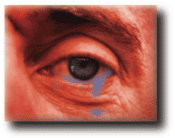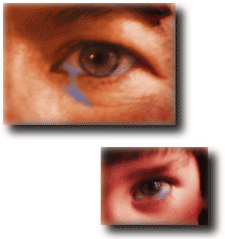 Continued...
In
contemporary Western culture, among all the varieties of interpersonal
love, parental love lacks a language. Parents often begin to recount
iconic scenes that are intended to show others the lovable qualities
of their children, only to find, in signs of their correspondents'
labored listening, that the storytelling is impossibly inadequate.
The parent's appreciation of the child's preciousness also acknowledges
the child's existential distance from the adults.
Continued...
In
contemporary Western culture, among all the varieties of interpersonal
love, parental love lacks a language. Parents often begin to recount
iconic scenes that are intended to show others the lovable qualities
of their children, only to find, in signs of their correspondents'
labored listening, that the storytelling is impossibly inadequate.
The parent's appreciation of the child's preciousness also acknowledges
the child's existential distance from the adults.
 Nostalgic
cryings, such as hearing at middle age a song that brings recollections
of one's youth, are examples of a similar gap between the generative
periods of one's own life. That younger person, the one who was
moved by those tunes 35 years ago, must still be around somewhere
in one's experience, but the distance is now so great that that
younger person cannot be addressed directly. One realizes that
one must have had that past, but now it has moved out of reach.
Nostalgic
cryings, such as hearing at middle age a song that brings recollections
of one's youth, are examples of a similar gap between the generative
periods of one's own life. That younger person, the one who was
moved by those tunes 35 years ago, must still be around somewhere
in one's experience, but the distance is now so great that that
younger person cannot be addressed directly. One realizes that
one must have had that past, but now it has moved out of reach.
Another
and more mysterious variety of nostalgic cryings is of the type
that evokes ties with a past that one never had. An example would
be finding oneself moved to tears by an ethnic song in a language
whose accents one recognizes but whose words one cannot understand.
 Stories
in which animals or, now, extraterrestrial creatures, develop
protolinguistic means of "communicating" their care for people
are effective movie conventions for touching viewers. Such events
highlight ontological gaps even as they show extraordinary achievements
in transcending them. The movie E.T. was famous for bringing
grown men to tears. Two powerful moments come when the creature
articulates the phrase "E.T. phone home" to explain his desire
to build an interplanetary communication device, and when a glow
appears at the end of E.T.'s finger as he seeks to heal the cut
finger of his ailing Earth friend, the child Elliott. Both moments
subtly exploit many traditional representations of heroic attempts
to transcend ontological language gaps, such as "Lassie come home"
and God's E.T.-like, elongated and relaxed finger as He reaches
toward Adam's hand as they float over the Sistine Chapel.
Stories
in which animals or, now, extraterrestrial creatures, develop
protolinguistic means of "communicating" their care for people
are effective movie conventions for touching viewers. Such events
highlight ontological gaps even as they show extraordinary achievements
in transcending them. The movie E.T. was famous for bringing
grown men to tears. Two powerful moments come when the creature
articulates the phrase "E.T. phone home" to explain his desire
to build an interplanetary communication device, and when a glow
appears at the end of E.T.'s finger as he seeks to heal the cut
finger of his ailing Earth friend, the child Elliott. Both moments
subtly exploit many traditional representations of heroic attempts
to transcend ontological language gaps, such as "Lassie come home"
and God's E.T.-like, elongated and relaxed finger as He reaches
toward Adam's hand as they float over the Sistine Chapel.
Hindi
movies regularly jerk tears from the audience by dramatizing existential
struggles to overcome gaps in communication. A recurrent provocation
is that of putting the audience in the position of trying to be
a silent bridge between two personal worlds that cannot speak
directly to each other. The moviegoer watches in a position of
transcendent understanding, wanting to shout out clues as two
brothers, separated at birth, move through situations in which
they are repeatedly about to but never quite succeed in recognizing
their common origin.





![]()
 Continued...
In
contemporary Western culture, among all the varieties of interpersonal
love, parental love lacks a language. Parents often begin to recount
iconic scenes that are intended to show others the lovable qualities
of their children, only to find, in signs of their correspondents'
labored listening, that the storytelling is impossibly inadequate.
The parent's appreciation of the child's preciousness also acknowledges
the child's existential distance from the adults.
Continued...
In
contemporary Western culture, among all the varieties of interpersonal
love, parental love lacks a language. Parents often begin to recount
iconic scenes that are intended to show others the lovable qualities
of their children, only to find, in signs of their correspondents'
labored listening, that the storytelling is impossibly inadequate.
The parent's appreciation of the child's preciousness also acknowledges
the child's existential distance from the adults.  Nostalgic
cryings, such as hearing at middle age a song that brings recollections
of one's youth, are examples of a similar gap between the generative
periods of one's own life. That younger person, the one who was
moved by those tunes 35 years ago, must still be around somewhere
in one's experience, but the distance is now so great that that
younger person cannot be addressed directly. One realizes that
one must have had that past, but now it has moved out of reach.
Nostalgic
cryings, such as hearing at middle age a song that brings recollections
of one's youth, are examples of a similar gap between the generative
periods of one's own life. That younger person, the one who was
moved by those tunes 35 years ago, must still be around somewhere
in one's experience, but the distance is now so great that that
younger person cannot be addressed directly. One realizes that
one must have had that past, but now it has moved out of reach.
 Stories
in which animals or, now, extraterrestrial creatures, develop
protolinguistic means of "communicating" their care for people
are effective movie conventions for touching viewers. Such events
highlight ontological gaps even as they show extraordinary achievements
in transcending them. The movie E.T. was famous for bringing
grown men to tears. Two powerful moments come when the creature
articulates the phrase "E.T. phone home" to explain his desire
to build an interplanetary communication device, and when a glow
appears at the end of E.T.'s finger as he seeks to heal the cut
finger of his ailing Earth friend, the child Elliott. Both moments
subtly exploit many traditional representations of heroic attempts
to transcend ontological language gaps, such as "Lassie come home"
and God's E.T.-like, elongated and relaxed finger as He reaches
toward Adam's hand as they float over the Sistine Chapel.
Stories
in which animals or, now, extraterrestrial creatures, develop
protolinguistic means of "communicating" their care for people
are effective movie conventions for touching viewers. Such events
highlight ontological gaps even as they show extraordinary achievements
in transcending them. The movie E.T. was famous for bringing
grown men to tears. Two powerful moments come when the creature
articulates the phrase "E.T. phone home" to explain his desire
to build an interplanetary communication device, and when a glow
appears at the end of E.T.'s finger as he seeks to heal the cut
finger of his ailing Earth friend, the child Elliott. Both moments
subtly exploit many traditional representations of heroic attempts
to transcend ontological language gaps, such as "Lassie come home"
and God's E.T.-like, elongated and relaxed finger as He reaches
toward Adam's hand as they float over the Sistine Chapel.